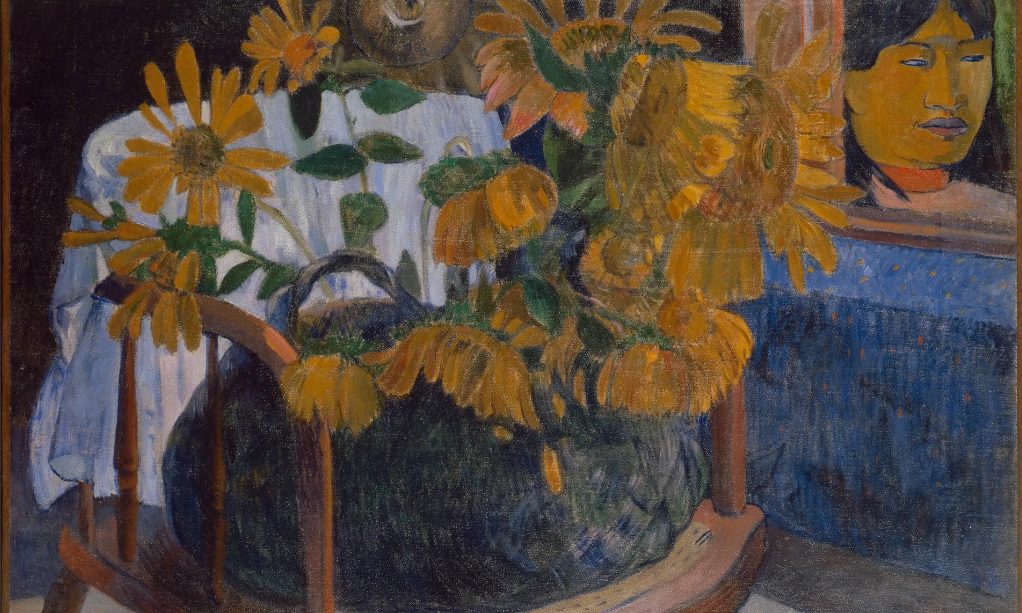Adventures with Van Gogh is a weekly blog by Martin Bailey, our long-standing correspondent and expert on the artist. Published every Friday, his stories range from newsy items about this most intriguing artist to scholarly pieces based on his own meticulous investigations and discoveries. © Martin Bailey
Paul Gauguin once brazenly claimed that he inspired Van Gogh to create the Sunflowers. This is patently untrue, since the still lifes were painted two months before Gauguin’s arrival at the Yellow House in Arles. The self-serving Gauguin wanted to claim credit for his colleague’s “signature” works.
Van Gogh’s Sunflowers (August 1888) Credit: National Gallery, London
Gauguin’s boast comes in a letter to his Paris-based friend André Fontainas, to whom he sent his 1902 manuscript Racontars de Rapin (Tales). This 28-page unpublished article was written in the Marquesan islands in French Polynesia. Yesterday (30 November) The Art Newspaper reported that the manuscript has just been acquired by London’s Courtauld Gallery.
Paul Gauguin’s Self-portrait (1901) (detail) Credit: Kunstmuseum Basel
In Tales, Gauguin lists 40 artists he admires. Van Gogh is included at the very end of the list, although nothing more is said about him, despite the fact that Gauguin lived and worked with him for nine weeks in the autumn of 1888. Their collaboration came to an abrupt end when Van Gogh mutilated his ear.
The last page of Gauguin’s Racontars de Rapin (Tales), which includes Van Gogh’s name at the end of a list of artists he admired Credit: Christie’s
In his letter to Fontainas, dated September 1902, Gauguin wrote that on his arrival in Arles, “following my advice and my instructions, he [Van Gogh] worked quite differently”—painting “yellow sunflowers on a yellow background”. This was a complete distortion of the truth: Van Gogh’s Sunflowers (August 1888) was actually hanging in Gauguin’s bedroom when he arrived.
Gauguin also claimed that it was he who encouraged Van Gogh to experiment, utilising the Dutchman’s “intelligence and fiery temperament”. In conclusion, Gauguin wrote that when discussing Van Gogh’s “noble nature I am forced to praise myself”.
Paul Gauguin’s Sunflowers on an Armchair (1901) Credit: State Hermitage Museum, St. Petersburg
The year before writing Tales, Gauguin painted a series of four still lifes with sunflowers. On three of these, the flowers are placed on chairs, which represent a nod to the Dutchman’s painting Van Gogh’s Chair (December 1888), now at London’s National Gallery.
When Gauguin painted his 1901 still lifes with sunflowers, they might be seen as representing a homage to Van Gogh. But bearing in mind his claims to Fontainas, it seems equally likely that he was appropriating his colleague’s famed motif. Gauguin may have wanted to add visual credence to his claim that he had provided Van Gogh’s inspiration.
Gauguin’s attempt was doomed to failure. Van Gogh’s series of Sunflowers is now universally recognised as his most popular paintings—and as all his very own work.
Paul Gauguin’s Sunflowers on an Armchair (1901) Credit: Emil Bührle Collection, long-term loan to the Kunsthaus Zürich
Other Van Gogh news:
Three prints of Van Gogh’s Old Man drinking Coffee (autumn 1882), with the promised donation on the right Credit: Van Gogh Museum, Amsterdam (Vincent van Gogh Foundation) and (right) Monique Hageman, on long-term loan to the Van Gogh Museum
Monique Hageman, a research assistant at the Van Gogh Museum since 1986, has given a rare lithograph of the artist’s Old Man drinking Coffee (autumn 1882) to her institution. This represents an act of huge generosity. Hageman bought the print on 10 May at the Leiden-based Burgersdijk & Niermans auction house, paying €275,000. It will eventually be bequeathed to the museum.
The museum already owns the two other extant examples of Old Man drinking Coffee (each was finished by the artist’s hand and is slightly different). All three lithographs went on display yesterday at the Amsterdam museum, until early in the new year.
Martin Bailey is the author of Van Gogh’s Finale: Auvers and the Artist’s Rise to Fame (Frances Lincoln, 2021, available in the UK and US ). He is a leading Van Gogh specialist and investigative reporter for The Art Newspaper. Bailey has curated Van Gogh exhibitions at the Barbican Art Gallery and Compton Verney/National Gallery of Scotland. He was a co-curator of Tate Britain’s The EY Exhibition: Van Gogh and Britain (27 March-11 August 2019).
Martin Bailey’s recent Van Gogh books
Bailey has written a number of other bestselling books, including The Sunflowers Are Mine: The Story of Van Gogh's Masterpiece (Frances Lincoln 2013, available in the UK and US), Studio of the South: Van Gogh in Provence(Frances Lincoln 2016, available in the UK and US), Starry Night: Van Gogh at the Asylum (White Lion Publishing 2018, available in the UK and US) and Van Gogh’s Finale: Auvers and the Artist’s Rise to Fame (Frances Lincoln 2021, available in the UK and US). Bailey's Living with Vincent van Gogh: the Homes and Landscapes that Shaped the Artist (White Lion Publishing 2019, available in the UK and US) provides an overview of the artist’s life. The Illustrated Provence Letters of Van Gogh has been reissued (Batsford 2021, available in the UK and US).
To contact Martin Bailey, please email [email protected]. Please note that he does not undertake authentications.
Read more from Martin's Adventures with Van Gogh blog here.

